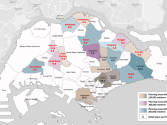Why Asia should zero in on demand management
By Peter MetcalfeAsia is a region of great promise; predicted to account for over half of global output by the middle of the century. Yet as volatility remains in global supply chains, competition intensifies and consumersare ever demanding, best practice demand management is an imperative.
Many organisations mistakenly consign demand planning as a supply chain or finance process,arguesPeter Metcalfe, Partner at business improvement specialists, Oliver Wight, who claims demand planning must become a sales and marketing process, if organisations are to reap the true financial benefits it can bring.
Effective demand planning, hinges on a clear understanding of where value is created, from the customer’s perspective. By definition, demand and forecasting must be led and managed by those closest to the customer and those who have the greatest understanding of what is happening at the point of consumption; that’s the sales and marketing team.
That’s not to say that supply and finance shouldn’t be involved at all. Naturally, it is vital they have a thorough understanding of the demand plan and a clear picture of its impact on the overall supply chain and flow of materials.
They need to identify any points where there may be a need for more inventory to support an increase in customer demand. But they should react only to formal instruction from sales and marketing.
In fact, integrating demand forecasting with financial planning is essentialbutthis too, is often overlooked. Indeed, according to a recent study* 64.3% of organisations’ Sales and Operations Planning processes fail because they are using it only for basic demand and supply balancing. In many cases, forecasts are merely a volume-only statistical process based on overall demand history and projections.
Integrated Business Planning (IBP) has become the process of choice for smarter organisations, since one of its key differentiators from traditional S&OP is the financial integration it provides, allowing the business to operate with a single set of numbers. Demand forecasts must be based on real demand history rather than just shipments, and any non-repeating historical events must be edited out.
Establishing this single set of numbers using fresh and accurate data is key to the entire IBP process but linking the volume forecast to revenue allows the true financial picture to be constantly measured and monitored, even to the point of rendering the annual budgeting process redundant, saving huge amounts of energy, time and grief all round. Failing to assess the real financial implications of meeting customer demand threatens to derail an organisation’s path to business excellence.
However this capability is present in a depressingly low 18 per cent of organisations*.
Although forecasting demand isn’t itself a supply process, integrating demand management through the supply chain is a must. Planning in isolation is debilitating whilst collaboration between supply chain partners in the planning process is transformational.
The key is to establish and prove the relationship, with multiple touch points throughout the partner organisations (not just between sales and purchasing), making it resilient to any future changes in personnel. Closer co-operation will help to ensure a more accurate view of demand, as well as allowing optimum performance.
In fact, supply chain collaboration reduces operating costs by up to 50% at the same time as improving customer service levels.
Whilstit’s essential demand management is owned by the sales and marketing team and integrated with financial planning, to become truly responsive to rapid changes in demand, companies must understand the difference between the need for up-to-date short term forecasts to drive supply chain response and the requirement for a longer term demand plan. Demand-sensing IT systems can help to understand what may really be needed in the short-term, however the supply chain must also be able to respond in an organised and formal way to the demand signal, with a view to the extended business horizon (24 to 36 months).
Without this, the only thing you can forecast with certainty is that customer service will be compromised and costs will spiral.
*Closing the gaps in Sales and Operations Planning
A Benchmark study of S&OP/IBP practices
CSCO Insights























 Advertise
Advertise










